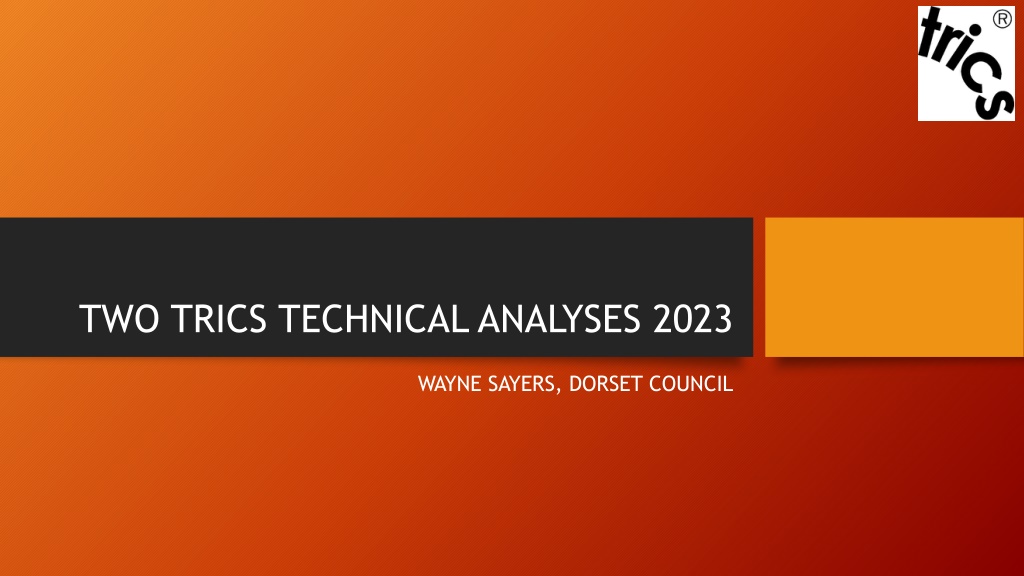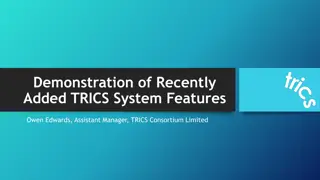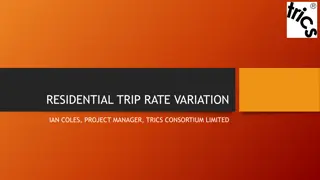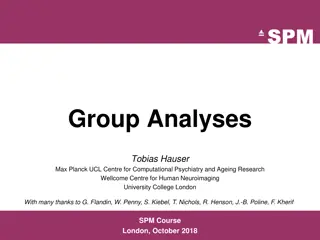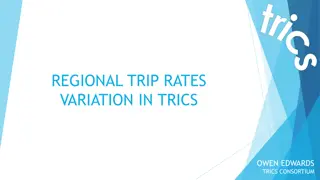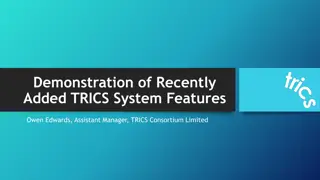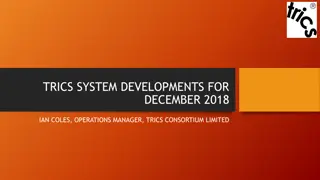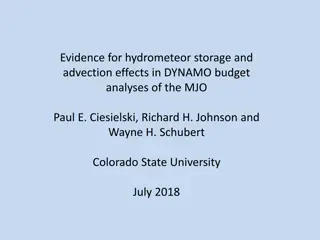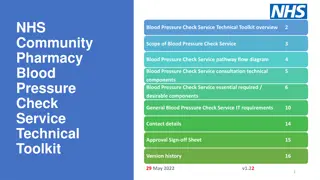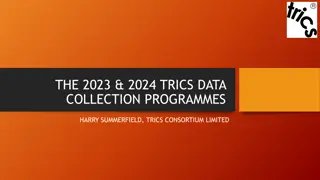TRICS Technical Analyses 2023
TRICS conducted two technical analyses in 2023: Fast Food Drive-Through Trip Generation Analysis and TRICS Vehicle Occupants Analysis for Selected Development Types. The studies aimed to provide valuable data to users without offering conclusive judgments based on specific criteria and methodologies. Survey samples and calculations methods were detailed to enhance transparency and understanding.
Download Presentation

Please find below an Image/Link to download the presentation.
The content on the website is provided AS IS for your information and personal use only. It may not be sold, licensed, or shared on other websites without obtaining consent from the author.If you encounter any issues during the download, it is possible that the publisher has removed the file from their server.
You are allowed to download the files provided on this website for personal or commercial use, subject to the condition that they are used lawfully. All files are the property of their respective owners.
The content on the website is provided AS IS for your information and personal use only. It may not be sold, licensed, or shared on other websites without obtaining consent from the author.
E N D
Presentation Transcript
TWO TRICS TECHNICAL ANALYSES 2023 WAYNE SAYERS, DORSET COUNCIL
TWO TRICS TECHNICAL ANALYSES IN 2023 Two technical analyses have been undertaken by TRICS so far in 2023. Many ideas for technical studies come from users through our annual User Survey. The two studies presented today are as follows: Fast Food Drive-Through Trip Generation Analysis 2023 TRICS Vehicle Occupants Analysis for Selected Development Types 2023
FAST FOOD DRIVE-THROUGH TRIP GENERATION ANALYSIS 2023 TRICS has been surveying fast food drive-through sites for many years (and multi-modal from 2000). It is a very popular land use. Recently new data fields have been added to this sub-category. By 2023 there were sufficient surveys to undertake this technical analysis. Drive-through coffee shops are not yet sufficient in number in the database to join this analysis (these are also popular). The aim was to provide clear, comparative data to our users without offering conclusions.
TRICS DEFINITION OF FAST FOOD DRIVE- THROUGHS (SUB-CATEGORY 06/D) Single fast food outlet with a drive- through facility, with or without restaurant facilities. May be within a retail/leisure park, but the site details and survey should only include the fast food outlet (both drive-through and other facilities). Trip rates are calculated by Gross Floor Area, Employees, or Parking Spaces.
SITE SELECTION CRITERIA All included surveys undertaken no earlier than 01/01/2000. Analyses split between surveys during 2000-2011 and surveys during 2012-2022 (to obtain a comparison over time). Analyses also split between weekdays (Mon-Fri) and weekend days (Sat-Sun). Analyses also split between Outer location types and Central location types (noting that the survey sample was much smaller for the Central grouping, meaning that only one set of calculations for weekdays across 2000-2022 was possible).
METHOD OF CALCULATIONS All trip rates to be calculated by 100m2 Gross Floor Area. All trip rates would be by Total Vehicles (inclusive of all 7 TRICS standard vehicle classifications insufficient data for a multi- modal analysis). Two-way trip rates (arrivals plus departures) to be presented for the 0700-2200 period for each set of calculations. Trip rates for peak arrivals and departures periods also to be presented (plus total two-way peak periods).
COMPARATIVE RESULTS There are 6 sets of tabular results contained within the technical report. Each table shows trip rates for the 0700-2200 survey period and peak periods. Each set of 2 tables cover surveys undertaken in 2000-2022, 2000-2011 and 2012-2022. This example shows weekdays during 2000-2022.
OBSERVATIONS TRICS does not provide any explanations, suggestions or reasoning behind any of the results. Single comparison between Outer and Central location type groupings was 2000-2022 (Mon-Fri). Two-way 0700-2200 trip rates were 340 trips per 100m2 GFA for the Outer grouping compared to 376 trips for the Central grouping, a difference of 10.8%. All other comparisons were for the Outer grouping only due to sample sizes.
WEEKDAY/WEEKEND COMPARISONS (OUTER LOCATION GROUPING) 2000-2022 Overall period trip rates (0700-2200) were 340 per 100m2 GFA on weekdays and 549 on weekend days (61.5% higher at weekends). 2000-2011 Overall period trip rates were 274 on weekdays and 402 on weekend days (46.5% higher at weekends). 2012-2022 Overall period trip rates were 375 on weekdays and 660 on weekend days (76.1% higher at weekends).
WEEKDAY COMPARISONS OVER TIME (OUTER LOCATION GROUPING) The total two-way weekday trip rate for the 0700-2200 period has grown from 272 per 100m2 of GFA during 2000-2011 to 374 during 2011-2022, an increase of 36.6%
WEEKEND COMPARISONS OVER TIME (OUTER LOCATION GROUPING) The total two-way weekend trip rate for the 0700-2200 period has grown from 402 per 100m2 of GFA during 2000-2011 to 660 during 2011-2022, an increase of 64.2%
TRICS VEHICLE OCCUPANTS ANALYSIS FOR SELECTED DEVELOPMENT TYPES 2023 TRICS first surveyed Vehicle Occupants when the first multi-modal surveys commenced in 2000. In 2008 the Vehicle Occupants mode split pie chart slice was sub- split between Single Vehicle Occupants and Multi-Vehicle Occupants. The Vehicle Occupants count provides a good indication of numbers of people per vehicle and potential car-sharing. The aim of this analysis was to provide clear Vehicle Occupants trip generation data across different land use types to our users without offering conclusions.
DEFINING THE VEHICLE OCCUPANTS COUNT The Vehicle Occupants count in TRICS includes all occupants of vehicles (except coach and bus passengers) but excludes drivers of vehicles picking up/dropping off passengers. The count splits vehicles with 1 occupant, 2 occupants up to 7 occupants. Example 1: Vehicle arrives with a driver plus 1 passenger, both visiting the site (1 Vehicle arrival and 2 Vehicle Occupant arrivals). Example 2: Vehicle arrives and departs, the driver dropping off 1 passenger visiting the site (1 Vehicle arrival, 1 Vehicle departure, and 1 Vehicle Occupant arrival).
THE VEHICLE OCCUPANTS COUNT & OCCUPANCY SPLIT GRAPH IN TRICS IMPORTANT: Note that the number of vehicles (bottom of table) may not equal the corresponding numbers in the Total Vehicles count, as drivers with zero occupants are not included in the Vehicle Occupants count.
SURVEY SAMPLES & METHOD OF ANALYSIS All included surveys undertaken no earlier than 01/01/2008, to ensure that Single Vehicle Occupants and Multi-Vehicle Occupants could be split in mode split pie charts. All analyses to be weekdays (Monday- Friday) only (insufficient data for weekends). Analyses also split between Outer location types and Central location types.
LAND USES AND SURVEY SAMPLES Trip rates to be calculated by GFA other than the following sub-categories: 03/A (per 1 dwelling) 03/C (per 1 dwelling) 07/C (per 1 hectare of site area)
NOTES ON SURVEY SAMPLES There were only 2 Town Centre surveys for 01/C (Discount Food Store), with 18 being Edge of Town Centre. There were no Town Centre surveys for 03/A (Houses Privately Owned), with all 18 being Edge of Town Centre. The vast majority of 03/A surveys were within the Outer location types grouping. There were only 2 Town Centre surveys for 05/G (GP Surgery), with 13 being Edge of Town Centre. We do not consider that any of these points compromise the validity of the results.
METHOD OF CALCULATIONS Trip rates to be calculated (where possible) using GFA (with exceptions previously noted). Vehicle Occupants trip rates to be calculated separately for Central and Outer location type groupings. Total survey duration trip rates to be presented first. Total Vehicles and Total People trip rates also calculated for additional context.
METHOD OF CALCULATIONS Vehicle Occupants to then be divided by Total Vehicles to provide some further context. CAVEAT: Vehicles in the Vehicle Occupants count will not necessarily match the vehicles in the Total Vehicles count (as explained before), so the ratio calculated will NOT show the average number of occupants per vehicle. Two-way Vehicle Occupants peak hour trip rates also to be presented. CAVEAT: For every set of surveys this peak period needs to have trip rates present for every survey, otherwise it cannot be shown as the peak hour (to avoid any misleading weighting or bias).
METHOD OF CALCULATIONS Average Vehicle Occupants mode split percentages (arr+dep) to be presented for each set of surveys, split between Single Vehicle Occupants and Multi-Vehicle Occupants. CAVEAT: Average mode split pie charts can only be calculated using trip rates for the period where data is available for every survey in a selected set. After each set of sub-category results is presented, a combined comparative summary table across the categories will be presented.
COMPARATIVE RESULTS There are 8 initial sets of tabular results contained within the technical report, one for each land use sub-category. Each table shows trip rates for the full survey duration, along with peak hour trip rates and Vehicle Occupants mode splits (example shown for 02/A Office), with all results split by the two location type groupings.
COMPARATIVE RESULTS Table 10 is a comparison of the land use sub-categories.
OBSERVATIONS TRICS does not provide any explanations, suggestions or reasoning behind any of the results. Numerous observations are made by land use sub-category based on the results tables and are detailed in the report. One of these, the full survey duration Vehicle Occupants trip rate comparisons by Central and Outer location type groupings, are as follows: 01/A (Food Superstore): Trip rate by 100m2 GFA was 16.3% lower for the Central grouping (109.6) than for the Outer grouping (127.5). 01/C (Discount Food Store): Trip rate by 100m2 GFA was 0.7% lower for the Central grouping (141.3) than for the Outer grouping (142.2).
OBSERVATIONS 02/A (Office): Trip rate by 100m2 GFA was 57.0% lower for the Central grouping (7.2) than for the Outer grouping (11.2). 03/A (Houses Privately Owned): Trip rate by 1 Dwelling was 5.5% lower for the Central grouping (6.7) than for the Outer grouping (7.1). 03/C (Flats Privately Owned): Trip rate by 1 Dwelling was 17.0% lower for the Central grouping (2.5) than for the Outer grouping (3.0).
OBSERVATIONS 05/G (GP Surgery): Trip rate by 100m2 GFA was 29.0% lower for the Central grouping (53.1) than for the Outer grouping (68.5). 06/A (Hotel): Trip rate by 100m2 GFA was 63.8% lower for the Central grouping (7.4) than for the Outer grouping (12.1). 07/C (Leisure Centre): Trip rate by 1 Hectare of Site Area was 29.0% lower for the Central grouping (598.8) than for the Outer grouping (772.7). Other observations include Vehicle Occupants divided by Total Vehicles, and mode splits of Single Vehicle Occupants, Multi- Vehicle Occupants and Total Vehicle Occupants (again comparing the Central and Outer location type groupings).
SINGLE/MULTI-VEHICLE OCCUPANTS MODE SPLITS Highest overall Vehicle Occupants mode split was Outer grouping for 01/A (Food Superstore) at 87.0% Lowest overall Vehicle Occupants mode split was Central grouping for 02/A (Office) at 31.9%.
TECHNICAL REPORTS AVAILABLE IN TRICS VERSION 7.10.2 Both technical reports will be available in TRICS version 7.10.2 (release date 30th June 2023). Reports will be freely accessible within the TRICS Library module.
